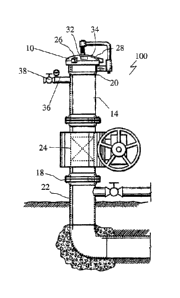Une partie des informations de ce site Web a été fournie par des sources externes. Le gouvernement du Canada n'assume aucune responsabilité concernant la précision, l'actualité ou la fiabilité des informations fournies par les sources externes. Les utilisateurs qui désirent employer cette information devraient consulter directement la source des informations. Le contenu fourni par les sources externes n'est pas assujetti aux exigences sur les langues officielles, la protection des renseignements personnels et l'accessibilité.
L'apparition de différences dans le texte et l'image des Revendications et de l'Abrégé dépend du moment auquel le document est publié. Les textes des Revendications et de l'Abrégé sont affichés :
| (12) Brevet: | (11) CA 2714132 |
|---|---|
| (54) Titre français: | FERMETURE POUR EMETTEUR OU RECEPTEUR DE RACLEUR DE PIPELINES |
| (54) Titre anglais: | CLOSURE FOR A PIPELINE PIG SENDER OR RECEIVER |
| Statut: | Réputé périmé |
| (51) Classification internationale des brevets (CIB): |
|
|---|---|
| (72) Inventeurs : |
|
| (73) Titulaires : |
|
| (71) Demandeurs : |
|
| (74) Agent: | WOODRUFF, NATHAN V. |
| (74) Co-agent: | |
| (45) Délivré: | 2015-04-07 |
| (22) Date de dépôt: | 2010-09-03 |
| (41) Mise à la disponibilité du public: | 2012-03-03 |
| Requête d'examen: | 2013-08-27 |
| Licence disponible: | S.O. |
| (25) Langue des documents déposés: | Anglais |
| Traité de coopération en matière de brevets (PCT): | Non |
|---|
| (30) Données de priorité de la demande: | S.O. |
|---|
Fermeture pour émetteur ou récepteur de racleur de pipelines comprenant un élément de fermeture primaire et un élément de fermeture secondaire. Lélément de fermeture primaire présente une face externe, une face interne et un orifice allant de la face externe à la face interne. Lélément de fermeture primaire est fixé à lémetteur ou au récepteur de racleur de pipelines afin de sceller une extrémité de fermeture lorsque lélément de fermeture primaire est en position fermée. Lélément de fermeture secondaire ferme lorifice sur lélément de fermeture primaire. Lélément de fermeture secondaire est mobile; il peut passer dune position fermée à une position ouverte pour permettre à un opérateur dinsérer un outil à travers lorifice, dans le passage de détournement, afin de manipuler le racleur de pipelines et de libérer la pression coincée avant douvrir la fermeture. Lélément de fermeture secondaire est fixé à lélément de fermeture qui scelle lorifice lorsque lélément de fermeture secondaire est en position fermée.
A closure for pipeline pig sender or receiver includes a primary closure body and a secondary closure body. The primary closure body has an outer face, an inner face and a port extending therethrough from the outer face to the inner face. The primary closure body is secured to the pipeline pig sender or receiver sealing a closure end when the primary closure body is in the closed position. The secondary closure body closes the port on the primary closure body. The secondary closure body is movable between a closed position and an open position to enable an operator to insert a tool through the port into the diversionary passage to manipulate the pipeline pig and release trapped pressure prior to opening the closure. The secondary closure body is secured to the primary closure body sealing the port when the secondary closure body is in the closed position.
Note : Les revendications sont présentées dans la langue officielle dans laquelle elles ont été soumises.
Note : Les descriptions sont présentées dans la langue officielle dans laquelle elles ont été soumises.

Pour une meilleure compréhension de l'état de la demande ou brevet qui figure sur cette page, la rubrique Mise en garde , et les descriptions de Brevet , États administratifs , Taxes périodiques et Historique des paiements devraient être consultées.
| Titre | Date |
|---|---|
| Date de délivrance prévu | 2015-04-07 |
| (22) Dépôt | 2010-09-03 |
| (41) Mise à la disponibilité du public | 2012-03-03 |
| Requête d'examen | 2013-08-27 |
| (45) Délivré | 2015-04-07 |
| Réputé périmé | 2018-09-04 |
Il n'y a pas d'historique d'abandonnement
| Type de taxes | Anniversaire | Échéance | Montant payé | Date payée |
|---|---|---|---|---|
| Le dépôt d'une demande de brevet | 200,00 $ | 2010-09-03 | ||
| Enregistrement de documents | 100,00 $ | 2011-10-05 | ||
| Taxe de maintien en état - Demande - nouvelle loi | 2 | 2012-09-04 | 50,00 $ | 2012-08-29 |
| Requête d'examen | 400,00 $ | 2013-08-27 | ||
| Taxe de maintien en état - Demande - nouvelle loi | 3 | 2013-09-03 | 50,00 $ | 2013-08-27 |
| Taxe de maintien en état - Demande - nouvelle loi | 4 | 2014-09-03 | 50,00 $ | 2014-08-26 |
| Taxe finale | 150,00 $ | 2015-01-22 | ||
| Taxe de maintien en état - brevet - nouvelle loi | 5 | 2015-09-03 | 100,00 $ | 2015-09-01 |
| Taxe de maintien en état - brevet - nouvelle loi | 6 | 2016-09-06 | 100,00 $ | 2016-09-02 |
Les titulaires actuels et antérieures au dossier sont affichés en ordre alphabétique.
| Titulaires actuels au dossier |
|---|
| BAKER, ALLEN D. |
| Titulaires antérieures au dossier |
|---|
| NELSON, DAVID L. |
| NOWICKI, TRENT C. |